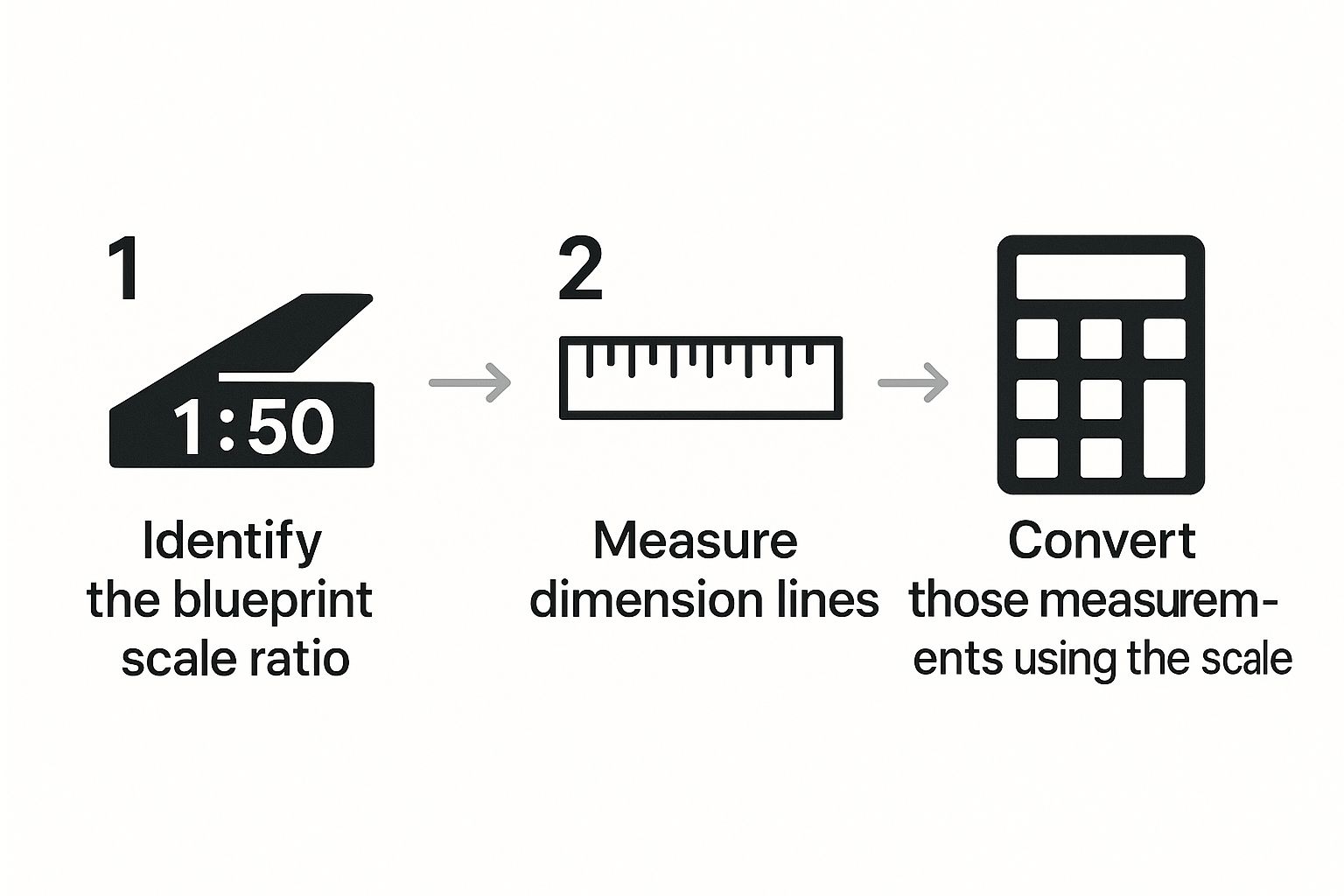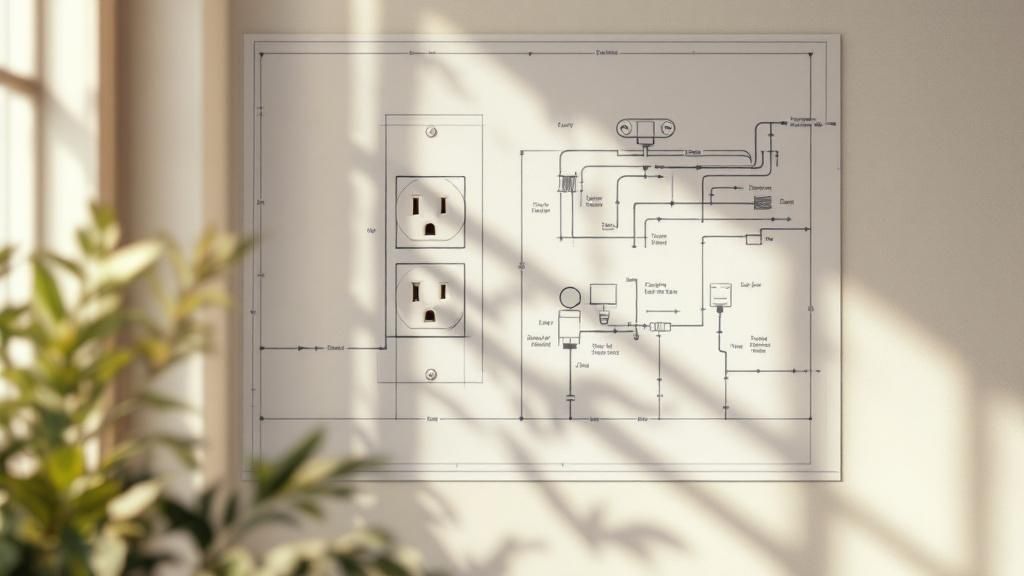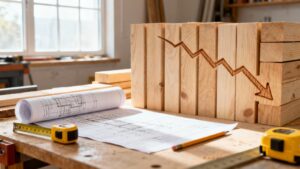Learning how to read construction blueprints comes down to knowing what to look for. Once you understand the key elements—the title block, legend, scale, and different drawings—you can interpret any plan, from a Berkeley remodel to a new commercial build in Oakland. Think of it as learning the alphabet before you try to read the book.
This guide will break down the process into clear, practical steps, moving past the jargon to give you real-world confidence.
Why Reading Blueprints Is a Critical Skill for Bay Area Projects

For builders, contractors, and even ambitious homeowners across the Bay Area, correctly reading blueprints is the bedrock of any successful project. Staring at a fresh set of plans can feel like deciphering a foreign language, but mastering this skill is non-negotiable.
Accurate plan interpretation is the best way to prevent expensive rework, keep your project on budget, and ensure every subcontractor is on the same page. It's the critical link between an architect's vision and a buildable reality.
The Blueprint as Your Project’s Foundation
A well-drawn blueprint is the entire story of a building. Misreading a single line or symbol can spiral into major structural headaches, budget blowouts, or permitting delays.
The importance of this skill extends beyond a single job site. Reading blueprints is a core competency in construction, manufacturing, and engineering. The U.S. construction industry was valued at roughly $2.1 trillion in 2024, with nearly every dollar of work dependent on the correct interpretation of plans.
For Bay Area professionals, mastering blueprints directly impacts project efficiency and profitability. It ensures that the high-quality, durable materials you carefully select are used correctly and to their full potential.
Ensure Local Compliance and Project Success
Every region has unique rules, and the Bay Area is no exception. A crucial part of reading blueprints is confirming that the plans comply with local regulations. This is a universal truth in construction; for instance, a project in another market requires a deep familiarity with understanding local building codes to avoid setbacks.
Here in the Bay Area, that means double-checking for compliance with:
- Seismic requirements specific to San Francisco and the East Bay.
- Title 24 energy codes, which dictate insulation, window performance, and more. According to the California Energy Commission, these standards save consumers billions in reduced energy bills.
- Wildland-Urban Interface (WUI) building standards, especially in hillside communities like Berkeley and Oakland.
Learning to read blueprints is about taking control of your project and ensuring every detail matches the client's vision while meeting all local standards.
How to Navigate a Complete Set of Construction Plans
A full set of construction blueprints is the complete instruction manual for the build. To get a handle on it, you need to understand how all the different documents work together.
The entire process begins long before a single line is officially drawn. Knowing the initial project phases, like the various stages of architectural design, helps you appreciate the planning behind every detail.
Start with the Cover Sheet and Title Block
Your first stop on any set of plans should always be the cover sheet and the title block on every page. This is the project's command center, containing essential administrative info:
- Project Name and Address: Confirms you’re working on the right job for the right location—critical for projects in dense areas like San Francisco.
- Architect, Engineer, and Contractor Information: Identifies the key players and their contact details.
- Drawing Index: A table of contents listing every sheet in the set.
- Revision History: A log of all changes and their dates. Always ensure you're working from the most recent version to avoid costly mistakes.
The title block is your anchor. Get in the habit of checking it first to save yourself major headaches.
Understanding Different Types of Drawings
A complete set of plans is broken down by discipline, each with its own focus and sheet code prefix. Knowing which sheet to grab for the right information is a core skill.
Here's a quick reference to help you find what you need at a glance.
Quick Guide to Blueprint Sheet Types
| Drawing Type | Sheet Code Prefix | Information You Will Find |
|---|---|---|
| Architectural | A | Floor plans, elevations, sections, window/door schedules, finish details. |
| Structural | S | Foundation plans, framing layouts, beam/column details, load-bearing info. |
| Mechanical | M | HVAC system layouts, ductwork routes, heating/cooling unit locations. |
| Electrical | E | Lighting plans, outlet/switch locations, circuit diagrams, panel schedules. |
| Plumbing | P | Water supply lines, drainage systems, fixture locations, pipe specs. |
| Landscape | L | Site grading, planting plans, hardscape features like patios and walkways. |
Architectural plans (A-sheets) are the master guide for the building's look and layout. They define the "what" and "where" of the entire design.
Structural plans (S-sheets) show the building's hidden skeleton—the foundation, load-bearing walls, and beams. These drawings are a top priority for anyone building in the seismically active Bay Area.

MEP, Landscape, and Other Specialized Plans
Beyond architectural and structural drawings, you'll find other specialized plans that are just as critical.
- Mechanical (M): These plans lay out Heating, Ventilation, and Air Conditioning (HVAC) systems.
- Electrical (E): This is your map for everything from outlets and light switches to the main panel.
- Plumbing (P): These drawings show the entire water supply and drainage system.
It's vital to cross-reference all plans to catch conflicts before they happen, like a plumbing pipe scheduled to run through a spot reserved for an HVAC duct. Knowing where to get the materials is the other half of the battle. Finding a local supplier that offers comprehensive https://truittandwhite.com/building-material-supplies-san-francisco can streamline the procurement process.
Learning the Language: How to Read Blueprint Lines and Symbols

Think of blueprints as a universal language spoken on every job site. Every line, symbol, and hatch pattern has a specific meaning. Getting fluent in this language is the only way to build with confidence.
This visual shorthand is how architects and engineers cram an incredible amount of information onto a single page. It ensures the framer, plumber, and electrician are all working from the same playbook.
Decoding the Alphabet of Lines
Not all lines are created equal. The weight and style of a line are packed with meaning, showing everything from a load-bearing wall to a property line.
Heavy, solid lines typically represent the most important objects, like a building's main outline. Lighter lines usually denote less critical components or objects further away.
You’ll see these line types on almost every set of plans:
- Object Lines: Bold, continuous lines that form the main outlines of a structure.
- Hidden Lines: Short, evenly spaced dashes that reveal what’s out of sight, like a beam above a ceiling.
- Center Lines: Alternating long and short dashes that mark the center of symmetrical items like windows or doors.
- Dimension Lines: Thin lines with arrows or tick marks that provide measurements.
- Phantom Lines: One long dash followed by two short ones, often showing movement like a door swing.
Mistaking a hidden line for an object line could lead a builder to cut an opening where a structural beam should be—a dangerous and expensive error.
Understanding Common Architectural Symbols
Once you know the lines, it’s time to learn the symbols. These simple pictograms stand in for real-world objects like doors and windows.
This is why the legend (or symbol key) is your best friend. Usually found on the cover sheet, the legend is the official "dictionary" for that specific set of drawings.
Pro Tip: When you start a new job in Berkeley or Oakland, snap a clear photo of the legend with your phone. Having it in your pocket saves countless trips back to the trailer and prevents on-the-fly guesses that lead to rework.
You'll find symbols for everything. Doors are shown as a straight line with an arc indicating the swing. For more on how these elements come together, our guide to combining window and door design with durability offers great insights.
Differentiating Material Symbols
Hatching patterns, sometimes called "pochi," are repeating patterns used in section drawings to show what materials are being used. This is vital for Bay Area projects, where material choices are influenced by seismic codes, WUI fire ratings, and sustainability standards.
You'll quickly learn to recognize:
- Concrete: A pattern of small triangles and dots.
- Wood Framing: Diagonal lines that look like wood grain.
- Insulation: A wavy or batt-like pattern filling a wall cavity.
- Brick or CMU: A pattern of repeating diagonal lines.
These patterns are a visual shortcut, helping you verify that specified materials—like fire-rated drywall or insulation required by California's Title 24 energy code—are installed correctly.
Using Scale and Dimensions for an Accurate Build
Once you can read the lines and symbols, the next step is turning drawings into buildable measurements. This is where scale and dimensions come in.
An architectural plan is a miniature version of a full-sized building. The scale, found in the title block, is the fixed ratio that makes this translation possible.
Architectural vs. Engineering Scales
For most residential and light commercial work in the Bay Area, you'll use the architectural scale. This system is based on fractions of an inch representing one foot.
Common architectural scales include:
- 1/4" = 1'-0": The workhorse for most floor plans.
- 1/8" = 1'-0": Used for larger buildings or overall site plans.
- 1/2" = 1'-0" to 3" = 1'-0": Reserved for critical details like window flashing or structural connections.
Occasionally, you might see an engineering scale (e.g., 1" = 20'), which is more common for large-scale site plans or civil drawings.
How to Use a Scale Ruler Correctly
An architect's scale ruler is a specialized tool for pulling measurements from a drawing. First, find the scale on the blueprint, then locate the matching edge on your ruler.
Line up the "0" mark with one end of the line. Read the main foot measurement, then use the finely graded section at the end to find the inches.
A critical rule every pro lives by is: trust the written dimensions over any measurement you take with a scale. The dimensions printed on the plan always supersede a scaled measurement. Scaling a drawing should be a last resort.
Reading Dimension Strings
On a blueprint, a series of measurements strung together is called a dimension string. These strings give you a running measurement of elements along a wall, like window and door locations.
A smart habit is to add up the individual measurements in a string to ensure they equal the overall dimension. This simple check can catch a drafting error before it gets built.
Mastering this is a cornerstone of learning how to read construction blueprints. For a deeper dive, you can explore this guide on professional construction drawing review.
A Practical Walkthrough of a Residential Floor Plan

Let's walk through a typical residential floor plan to see how these concepts work together on the job. This is a repeatable process for any blueprint that lands on your desk.
The first thing any experienced Bay Area builder does is get their bearings. Find the north arrow. This simple symbol tells you how the building sits on the property, dictating everything from morning sun to landscape planning.
Identifying Key Structural and Layout Elements
As you trace the layout, scan for crucial structural information. Look for thicker wall lines or callouts indicating load-bearing walls. These are the bones of the building and cannot be altered without consulting a structural engineer.
Next, zero in on the dimensions. Follow the dimension strings around the building's exterior to get the overall footprint, then check individual room sizes.
A Pro’s First Glance: A seasoned contractor doesn't just see rooms; they see systems. They instantly spot potential conflicts, like how a plumbing run might clash with HVAC ductwork or where a pocket door leaves no room for an electrical outlet.
Tracing the Flow and Cross-Referencing Details
Cross-referencing plans and schedules is essential. Let's trace a window to see how this works.
- Find the Symbol: On the floor plan, find a window symbol with a tag, like W-01.
- Locate the Schedule: Take that tag (W-01) and flip to the Window Schedule in the architectural sheets.
- Read the Details: The schedule provides the manufacturer, model, rough opening size, and glazing type. This is the exact information you need to order the right unit from a supplier like Truitt & White.
This back-and-forth process is the heart of reading blueprints. The floor plan shows you where it goes, and the schedules tell you what it is.
Applying the Walkthrough to Other Plans
This same practical walkthrough works for more than just house plans. Our guide on building a deck offers expert advice for success, and the blueprint reading process is identical.
You’ll begin by orienting the deck to the house, identifying locations for footings, and cross-referencing material callouts. The core process never changes, whether you're framing a new home in Oakland or remodeling in Berkeley.
Frequently Asked Questions About Reading Blueprints
What is the most important thing to check first on a blueprint?
Always start with the title block, usually on the cover sheet. It contains the official project name, address, architect/engineer contacts, and—most critically—the latest revision date. Confirming you have the current version is the single most important step to avoid costly rework.
What should I do if a dimension is missing or seems wrong?
Stop work immediately and submit a Request for Information (RFI) to the architect or project manager. Never guess or assume a measurement. It is always better to pause for clarification than to build something incorrectly, as a single bad measurement can cause a cascade of problems.
How do I know what all the symbols and abbreviations mean?
Refer to the legend or symbol key, which is the official "dictionary" for the plan set. You will typically find it on the cover sheet or one of the first few pages. Always check the project-specific legend, as architects may use unique symbols.
What’s the difference between architectural and structural drawings?
Architectural drawings (A-sheets) focus on aesthetics, layout, finishes, and functional dimensions—the look and feel. Structural drawings (S-sheets) detail the building's "skeleton," including the foundation, beams, and load-bearing walls required for safety, which is crucial for meeting Bay Area seismic codes. For design ideas, see these five jaw-dropping outdoor spaces.
Can I use digital tools to help read blueprints?
Absolutely. Digital tools like Bluebeam Revu, AutoCAD, and various mobile apps are now standard for efficiently reading plans. They allow you to zoom in on details, take accurate digital measurements, and collaborate with your team, ensuring everyone is on the same page.
For all your project needs, from high-quality lumber to premium windows and doors, the experts at Truitt & White are here to help. Visit our Berkeley showroom for professional advice and a comprehensive selection of building materials.









